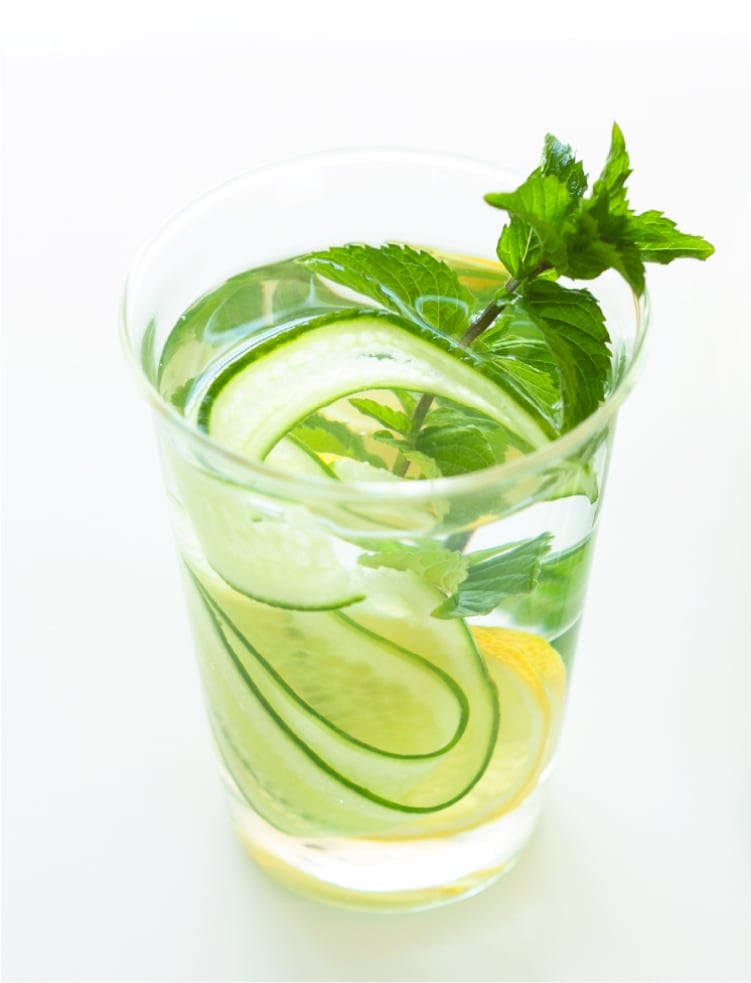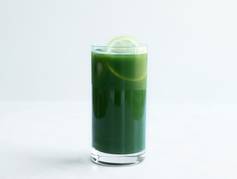Articles
Juicing for Hormone Health
Meet Luise, a dedicated mother of 3, living in the heart of Stockholm, Sweden, who balances life and work with her interest in women's health, being the creative mind behind Green Kitchen Stories, and also being passionate about holistic nutrition. Luise is a Licensed Midwife and certified nutritional therapist. She combines the worlds of nutrition, cooking, and midwifery, allowing her to approach wellness from multiple angles.
Luise's lifestyle reflects a commitment to organic food, healthy habits, and sustainable choices. She has a love for therapeutic activities like saunas and ocean dips, and as a wellness enthusiast, she values a mindful and balanced approach to life.

In my work, I meet many women who ask me for nutritional guidance when they’re not feeling aligned with their bodies and are experiencing unpleasant symptoms or having trouble with their cycles, fertility, or postpartum. Many women deal with issues like irregular menstrual patterns or other hormone issues that result in pain, mood swings, or something more serious.
They also deal with hormonal imbalances at some point in their lives, and don’t even realize that so many of their symptoms are related to hormones.[1]
I have gathered my hormone health knowledge to share, along with some tools that can be helpful toward a more balanced menstrual cycle and hormone health journey. Plus, you’ll find some easy and delicious juice recipes that can support you throughout the month.
As always, when adopting a new diet or lifestyle, it’s important to check in with a professional about your individual needs.
Understanding Your Hormones
Hormones are made and released as part of your endocrine system and help coordinate many different functions throughout your body.
Hormones are chemical messages, like text messages sent from an endocrine gland through your blood to target cells,” writes Dr. Sara Szal Gottfried, a Harvard-educated medical doctor and bestselling author. “Hormones influence your behavior, emotions, brain chemicals, immunity, and metabolism. When your hormones are in balance, you look and feel your best. But when they are imbalanced, they can make your life miserable.”
Hormone imbalances often develop at various cycles of life including puberty, pregnancy and after childbirth (postpartum), and during perimenopause and menopause.
Two pillars of reproductive health are the hormones estrogen and progesterone, which are responsible for a functioning cycle.
Estrogen
Estrogen is the driving force behind the early phases of the menstrual cycle. It fuels the development and maturation of your reproductive organs, creating the base upon which the rest of the cycle unfolds. As your body prepares for potential pregnancy, estrogen crafts the lush uterine lining to be ready. During ovulation, estrogen aids in releasing an egg. Estrogen supports cardiovascular health, enhances skin appearance, and influences emotional well-being.
Progesterone
As ovulation occurs and the potential for pregnancy arises, progesterone steps in to prepare the uterine lining, turning it into a great environment for a fertilized egg. If pregnancy doesn't happen, progesterone levels drop, and the cycle starts again. Besides pregnancy, progesterone supports bone health, mood balance, and cardiovascular health.
Both estrogen and progesterone are two hormones that are essential for reproductive health, fertility, pregnancy support, hormone balance, mood regulation, and bone health. They play a crucial role in various physiological processes in the female body, contributing to overall well-being and reproductive function.

Natural Rhythms
All bodies are unique, so paying attention to how you feel during different phases of the hormone cycle is a great first step to improved health. Many essential building blocks play a vital role throughout the entire hormonal cycle. Healthy fats and proteins, for instance, serve as fundamental components that support hormonal balance and overall well-being across all stages of life.
In general, hormone health comes down to a few key factors that include nutrition, gut health, inflammation, stable blood sugar, stress management, quality sleep, and movement.
Remember that individual nutritional needs may vary, and it’s essential to maintain a well-balanced diet to support your specific health requirements. If you have health concerns or hormonal imbalances, it’s best to consult with a healthcare professional or medical doctor.
As we dive into the specifics of hormone health, let me assure you that striving for perfection is not necessary. We are all works in progress, and it’s much more about progress than perfection on any wellness journey. While you don’t have to be a superhuman, a sprinkle of self-care and attention to these essential factors can go a long way.

Powerful Nutrients to Support Hormone Health
The female body is complex, but with the right nutritional adjustments, you can work to balance your hormones and support your natural cycles.
Fresh, whole, plant-based foods are incredible allies for hormone health. Aim to increase your servings of vegetables and fruits, focusing on dark leafy greens, which are loaded with essential nutrients that support the body to help keep hormones in balance. Vibrant vegetables like kale, spinach, Swiss chard, collard greens, and others are full of vitamins A, E, K, and folate, plus minerals such as calcium and potassium, along with fiber and phytonutrients.[2] Green juice is an easy and effective way to add more of these greens into your diet. You can also add them to smoothies, soups, and salads.
Vitamin C & Iron
Both of these important nutrients help synthesize hormones and support the immune system. They also work in synergy as adequate vitamin C intake helps enhance iron absorption. In particular, this combination can be helpful for those who are plant-based or consume a more plant-forward diet.
There are actually two types of iron: heme iron and non-heme iron. Heme iron is found mostly in red meats and organ meats, while non-heme iron is found in plants like beans, beets, lentils, spinach, kale, tofu, and apricots. When you consume iron and vitamin C together, it improves the body’s ability to absorb the non-heme iron. Foods rich in vitamin C include citrus, strawberries, tomatoes, and bell peppers.
Vitamin D
This vitamin is considered a hormonal precursor. The body uses vitamin D to make calcitriol, a potent hormone capable of signaling more than 1,000 different genes to express or suppress themselves. When it comes to women’s health, it can be beneficial for the production of epithelial cells found in the uterus, which helps maintain a healthy uterus lining.[3] Vitamin D increases levels of progesterone and estrogen.
Studies suggest that more than 40 percent of people are deficient in vitamin D.[4] If you need to boost your levels, both sunshine and supplementation can help. Vitamin D is often hailed as the “sunshine vitamin.” Start by getting sun on your skin for about 15 minutes a few times a week. After that, it’s important to apply sunscreen and practice other sun safety tips, as too much sun exposure can damage your skin and lead to other health issues. You can get your vitamin D levels checked with a health professional to see if you are low and get a recommendation for the dosage you need to supplement.
Omega-3 Fatty Acids
These healthy fats should be included in your daily routine, as they are involved in hormone production and regulation. They can help maintain balanced levels of hormones, such as estrogen and progesterone. Omega-3s help improve blood flow by promoting the flexibility of blood vessels, which can be particularly beneficial during the menstrual phase when blood flow increases due to shedding of the uterine lining. These fatty acids are associated with improved fertility by supporting healthy ovulation, enhancing the quality of cervical mucus, and promoting a favorable uterine environment for implantation. Omega-3s also have remarkable power in hormone health, due to their strong anti-inflammatory and mood-boosting effects. The discomfort that often starts during the menstrual cycle, including cramps, bloating, and mood swings, is rooted in inflammation. Omega-3s have been linked to improved mood and mental well-being.[5] They support brain health and neurotransmitter function, which can contribute to a more stable mood throughout the cycle.
Find these healthy fats in chia seeds, flaxseeds, and walnuts; in high-quality omega-3 supplements; or for those who consume fish, in salmon, mackerel, and sardines. Flaxseeds are so nourishing for ovaries and support healthy estrogen elimination, as well as healthy progesterone production throughout your life. Simply sprinkle 1 to 2 tablespoons of ground organic flaxseeds onto your breakfast or in smoothies.
Magnesium
Some health experts refer to magnesium as the miracle mineral for its ability to help remedy hormonal imbalances. This essential electrolyte is the fourth most abundant mineral in the human body.[6] It supports the production of sex hormones by helping the liver metabolize them and excrete unwanted estrogen metabolites. It also helps balance thyroid hormones, as magnesium deficiency is associated with elevated thyroid antibody levels.[7] Magnesium can also help lower prostaglandins, the inflammatory compounds that drive period pain, helping ease menstrual cramps. It’s also known to help calm the nervous system, helping relieve headaches and mood fluctuations associated with PMS.
Vitamin C & Iron
Both of these important nutrients help synthesize hormones and support the immune system. They also work in synergy as adequate vitamin C intake helps enhance iron absorption. In particular, this combination can be helpful for those who are plant-based or consume a more plant-forward diet.
There are actually two types of iron: heme iron and non-heme iron. Heme iron is found mostly in red meats and organ meats, while non-heme iron is found in plants like beans, beets, lentils, spinach, kale, tofu, and apricots. When you consume iron and vitamin C together, it improves the body’s ability to absorb the non-heme iron. Foods rich in vitamin C include citrus, strawberries, tomatoes, and bell peppers.
Vitamin D
This vitamin is considered a hormonal precursor. The body uses vitamin D to make calcitriol , a potent hormone capable of signaling more than 1,000 different genes to express or suppress themselves. When it comes to women’s health, it can be beneficial for the production of epithelial cells found in the uterus, which helps maintain a healthy uterus lining.[3] Vitamin D increases levels of progesterone and estrogen.
Studies suggest that more than 40 percent of people are deficient in vitamin D.[4] If you need to boost your levels, both sunshine and supplementation can help. Vitamin D is often hailed as the “sunshine vitamin.” Start by getting sun on your skin for about 15 minutes a few times a week. After that, it’s important to apply sunscreen and practice other sun safety tips, as too much sun exposure can damage your skin and lead to other health issues. You can get your vitamin D levels checked with a health professional to see if you are low and get a recommendation for the dosage you need to supplement.
Omega-3 Fatty Acids
These healthy fats should be included in your daily routine, as they are involved in hormone production and regulation. They can help maintain balanced levels of hormones, such as estrogen and progesterone. Omega-3s help improve blood flow by promoting the flexibility of blood vessels, which can be particularly beneficial during the menstrual phase when blood flow increases due to shedding of the uterine lining. These fatty acids are associated with improved fertility by supporting healthy ovulation, enhancing the quality of cervical mucus, and promoting a favorable uterine environment for implantation. Omega-3s also have remarkable power in hormone health, due to their strong anti-inflammatory and mood-boosting effects. The discomfort that often starts during the menstrual cycle, including cramps, bloating, and mood swings, is rooted in inflammation. Omega-3s have been linked to improved mood and mental well-being.[5] They support brain health and neurotransmitter function, which can contribute to a more stable mood throughout the cycle.
Find these healthy fats in chia seeds, flaxseeds, and walnuts; in high-quality omega-3 supplements; or for those who consume fish, in salmon, mackerel, and sardines. Flaxseeds are so nourishing for ovaries and support healthy estrogen elimination, as well as healthy progesterone production throughout your life. Simply sprinkle 1 to 2 tablespoons of ground organic flaxseeds onto your breakfast or in smoothies.
Magnesium
Some health experts refer to magnesium as the miracle mineral for its ability to help remedy hormonal imbalances. This essential electrolyte is the fourth most abundant mineral in the human body.[6] It supports the production of sex hormones by helping the liver metabolize them and excrete unwanted estrogen metabolites. It also helps balance thyroid hormones, as magnesium deficiency is associated with elevated thyroid antibody levels.[7] Magnesium can also help lower prostaglandins, the inflammatory compounds that drive period pain, helping ease menstrual cramps. It’s also known to help calm the nervous system, helping relieve headaches and mood fluctuations associated with PMS.

Staying Hydrated
Hydration is essential throughout the entire cycle to support hormone balance. Additionally, avoiding excessive caffeine and alcohol can help minimize hormonal disruptions. Try caffeine alternatives like herbal teas, bone broths, or dandelion or chicory root “coffee.” Matcha green tea is also a lower caffeine option with added antioxidants and anti-inflammatory properties.
One of my favorite tips for staying hydrated throughout the day is to add soluble vitamin C to a large water bottle with water, lemon juice, and sea salt. Cucumber and lemon are also a hydrating duo. Add these two to your daily juice for an extra hydration boost.
Eat for Your Cycles
Let’s explore how these building blocks, along with other key nutritional considerations, contribute to women's hormone health during the four phases of a cycle. In addition to each phase, there’s a juice recipe focusing on the beneficial nutrients.

Revitalizing Juice
Beetroot, strawberries, pomegranate, lemon, ginger, cucumber
During the menstrual phase, which is the first few days of the cycle, iron-rich foods can be beneficial to replenish blood loss. Incorporating foods high in vitamin C can enhance iron absorption. Additionally, omega-3 fatty acids found in fish oil or in algae oil, flaxseed oil, and chia seeds can help reduce inflammation and support mood stability. Cruciferous vegetables are especially beneficial for women; these include broccoli, Brussels sprouts, kale, cabbage, and cauliflower. When these vegetables are chewed and broken down during digestion, glucosinolates (phytochemicals) are transformed into biologically active compounds that are especially beneficial for women’s hormone health.
Beneficial movements for phase 1: Low-impact exercises for promoting comfort and gentle activity are good for this phase, including yoga, mobility, long walks, and stretching.

Mineral-Rich Juice
Broccoli, kale, spinach, cucumber, lemon, pomegranate
This phase is the longest of your menstrual cycle and essential for follicle development, leading to ovulation. As the follicular phase begins, focus on consuming a variety of fruits, vegetables, and whole grains to provide essential nutrients and fiber. Including sources of B vitamins and zinc can also support hormone production and regulate the menstrual cycle. You find vitamin B in foods like eggs, firm tofu, salmon, dark green vegetables, cheese, and brown rice. Zinc is important for fertility and hormone balance and can be found in foods like sesame seeds, pumpkin seeds, chickpeas, oysters, shellfish, beans, nuts, and poultry. Fiber promotes digestive health and aids in estrogen metabolism. You can find it in whole fruits, whole vegetables, and complex whole grains. A healthy gut microbiome can support estrogen metabolism and balance. Focus on probiotics like yogurt, kefir, and fermented vegetables that contain beneficial probiotics, or consider a probiotic supplement.
Beneficial movements for phase 2: More high-impact exercises such as HIIT workouts, power walks, and running.

Power Up Juice
Kale, grapefruit, oranges, lemon, berries
During the ovulatory phase, a balanced diet rich in proteins, healthy fats, and antioxidants is recommended. Antioxidant-rich foods like berries, leafy greens, and nuts can help neutralize free radicals and support overall fertility. Antioxidants also protect cells from oxidative stress. Antioxidant ingredients can be identified through their many colors—the more colorful the better. Think blueberries, pomegranate, broccoli, carrots, beetroot, sweet potato, pumpkin, squash, and matcha. Hormone production and hormone balance are supported by healthy fats, which are found in avocados, olive oil, nuts and nut butters, seeds and seed butter, coconut oil, butter, and fatty fish rich in omega-3s.
Beneficial movements for phase 3: HIIT workouts, circuits, heavy weight training, power walks, and running. You can enjoy more high-impact workouts, as your energy levels rise to their highest in this phase.

Low Sugar Juice
Celery, cucumber, cabbage, lemon, mint, ginger
The luteal phase is the time leading up to menstruation, and it is crucial to maintain stable blood sugar levels during this time. Incorporating complex carbohydrates, such as whole grains, sourdough bread, sweet potatoes, and lentils can help. Some of my gluten-free favorite whole grains are buckwheat, millet, quinoa, brown rice, and wild rice; foods rich in magnesium and vitamin B6, like legumes (lentils, beans, and chickpeas). Dark leafy greens may help ease premenstrual symptoms at this time. Choose from broccoli, spinach, kale, dinosaur kale, Romaine lettuce, arugula, and rainbow chard. Dark green leafy vegetables are also great sources of fiber, which is a bonus for digestion. To help alleviate premenstrual symptoms, you can rev up your intake of magnesium found in nuts, seeds, whole grains, and leafy greens. You can even try a bath with magnesium salt to help muscle cramps, or take magnesium supplements late in the evening.
Beneficial movements for phase 4: Yoga, Pilates, flow movements, weighted exercise, and long walks.

From the first menstrual phase to menopause and every moment in between, these nutritional elements act as crucial players in maintaining hormone production, regulation, and synthesis. By prioritizing nourishing fats, high-quality proteins, and a balanced diet, women can build a foundation for a healthier, more harmonious hormonal journey.
sources:
- https://www.ncbi.nlm.nih.gov/pmc/articles/PMC8242938
- https://www.ncbi.nlm.nih.gov/pmc/articles/PMC7770496
- https://www.ncbi.nlm.nih.gov/pmc/articles/PMC6075634
- https://www.ncbi.nlm.nih.gov/pmc/articles/PMC6122064
- https://www.ncbi.nlm.nih.gov/pmc/articles/PMC5610883
- https://www.sciencedirect.com/science/article/pii/S2352364621000079
- https://www.ncbi.nlm.nih.gov/pmc/articles/PMC6028657
- Choosing a selection results in a full page refresh.
- Press the space key then arrow keys to make a selection.




